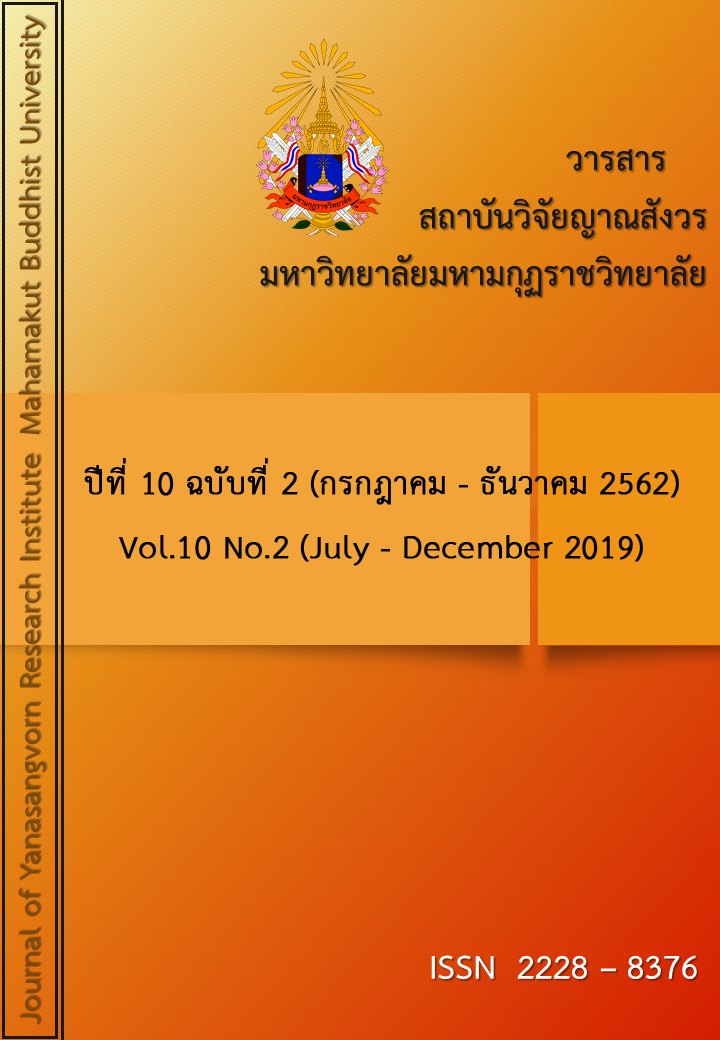THE BAN-KHLONG-KAE SCHOOL STUDENTS’ UNDERSTANDING OF THE OPERATION OF MORALITY TEACHING MONKS IN SMUT SAKORN PROVINCE
Main Article Content
Abstract
The purposes of this research were : 1) to study the Ban-khlong-kae school students’ understanding of the operation of morality teaching monks in Smut Sakorn Province 2) to compare of the students’ understanding of the operation of morality teaching monks therein, and 3) to investigate their suggestions of problem and its solutions in understanding the operation of morality teaching monks therein. The samples were 146 students of Ban-khlong-kae school in Smut Sakorn Province, classified by gender, age, academic year and family status. The Taro Yamane’s formula and stratified random sampling were used to determine the sampling size. The research tool used in this study was questionnaire. Statistics for data analysis were Frequency, Percentage, Mean, Standard deviation, One-Way ANOVA. The research findings were as follows: 1) the average of all 4 aspects of the Ban-khlong-kae school students’ understanding of the operation of morality teaching monks in Smut Sakorn Province was found at moderate range ( =1.54); They were teaching material ( =1.63, S.D.=0.18), teaching method ( =1.57, S.D.=0.13), Buddhism subject content ( =1.50, S.D.=0.13) and assessment ( =1.4, S.D.=0.15) respectively. 2) The overall hypothesis test results were shown that the Ban-khlong-kae school students’ understanding of the operation of morality teaching monks in Smut Sakorn Province, with different sex, age, academic year and family status, was not significant. 3) The Ban-khlong-kae school students provided their suggestions on the problems and its solutions in 4 aspects: (1) the teaching method (2) the learning material (3) the assessment and (4) the Buddhism subject contents. Thus, the morality teaching monks should train the students to be responsible for their duties, i.e., paying attention in their studies and encourage them to be honest to themselves and others.
Article Details
References
พระธรรมปิฎก. (ป.อ. ปยุตฺโต, 2544). พุทธวิธีในการสอน. กรุงเทพมหานคร : โรงพิมพ์บริษัท สหธรรมิก จำกัด.
วศิน อินทสระ. (2526). การวัดและประเมินผลการศึกษาตามแนวพุทธศาสตร์. ในศึกษาศาสตร์ตามแนวพุทธศาสตร์. กรุงเทพมหานคร : กราฟิคอาร์ต.
บุญหนา จิมานัง และคณะ. (2551). การประเมินประสิทธิภาพการสอนของพระสอนศีลธรรมในสถานศึกษาเขตปกครองคณะสงฆ์ภาค 9. รายงานการวิจัย. สำนักวิชาการ : มหาวิทยาลัยมหา จุฬาลงกรณราชวิทยาลัย วิทยาเขตขอนแก่น.
ปรมะ สตะเวทิน. (2546). การสื่อสารมวลชน : กระบวนการและทฤษฎี. พิมพ์ครั้งที่ 3. กรุงเทพมหานคร : ภาพพิมพ์.
พระดำรงค์เดช ทองสิมา. (2554). การสอนวิชาพระพุทธศาสนาของครูพระสอนศีลธรรมในมุมมองของนักเรียนโรงเรียนหนองนกไข่ ตำบลหนองนกไข่ อำเภอกระทุ่มแบน จังหวัดสมุทรสาคร. ปริญญานิพนธ์การศึกษามหาบัณฑิต. บัณฑิตวิทยาลัย : มหาวิทยาลัยมหามกุฏราชวิทยาลัย
พระสมชัย กิตฺติญาโณ, ดร. และคณะ. (2560). ความเข้าใจในบทบาทพระสงฆ์ด้านการเผยแผ่พระพุทธศาสนาของนักศึกษามหาวิทยาลัยมหามกุฏราชวิทยาลัย วิทยาเขตสิรินธรราชวิทยาลัย. การประชุมวิชาการนำเสนอผลงานวิจัยระดับชาติประจำปี 2560 (บัณฑิตวิทยาลัย : มหาวิทยาลัยมหามกุฏราชวิทยาลัย), หน้า 560 - 569.
พระสมุห์วิสุทธิ์ศรี เทียนวิเศษ. (2551). ทัศนคติของนักเรียนช่วงชั้นที่ 3 ที่มีต่อครูผู้สอนวิชาพระพุทธศาสนา โรงเรียนวัดคู้บอน ปีการศึกษา 2550. ปริญญานิพนธ์การศึกษามหาบัณฑิต.บัณฑิตวิทยาลัย : มหาวิทยาลัยมหามกุฏราชวิทยาลัย.
ระวีวรรณ วุฒิประสิทธิ์ และคณะ. (2530). หลักการสอน. กรุงเทพมหานคร : ศูนย์การศึกษาสำหรับครูทางวิทยุไปรษณีย์ กรมการฝึกหัดครู.


